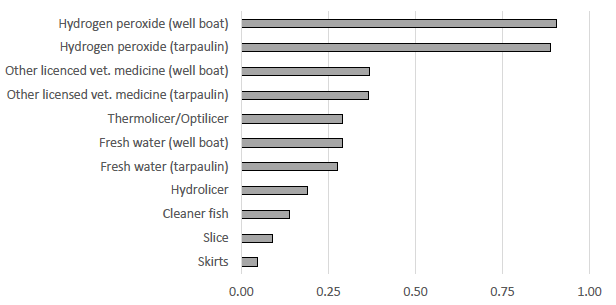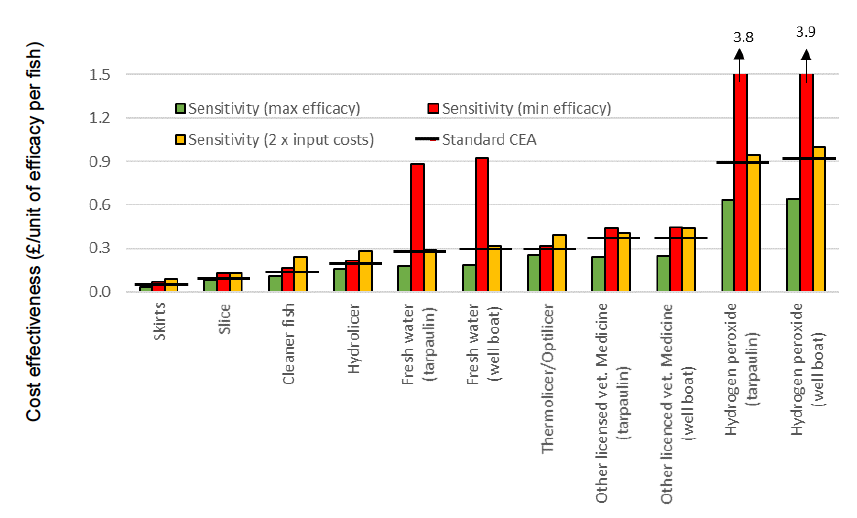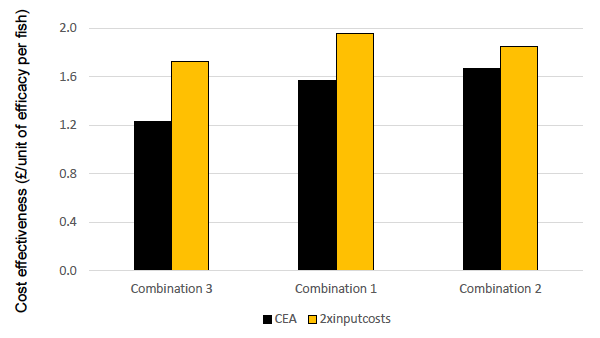Sea lice management measures for farmed salmon production: research
Research report comparing the socio-economic and environmental cost-effectiveness of sea lice treatment measures used on Scottish salmon farms.
4. LCA and CEA results
We integrated LCA and CEA, with the LCA results i.e. environmental impacts (GHG emissions) of the whole salmon production chain when applying different types of sea lice management measures (Table 10), feeding as input variables into the CEA. In this section we present the results of the combined LCA & CEA analysis.
Relative cost-effectiveness for theoretical single use sea lice management measures and combination measures for a full production cycle are presented separately in Figure 7 and 9, because they are not comparable.
Caution should be applied when comparing cost-effectiveness of single use measures based on the limitations previously mentioned regarding data available for this study as well as the consequent simplified modelling assumptions.

The horizontal bars indicate the cost of the sea lice management measures for the same unit of effectiveness per fish, implying that the longer the bar, the higher the cost to reach the same efficacy. In-feed and skirts measures all cost under £0.10 per fish per unit of effectiveness, and were the group of most cost-effective measures. The cleaner fish, fresh water, physical removal measures and the licensed veterinary medicines were among the second most cost-effective measures, with a cost ranging between £0.14 to £0.37 per fish per unit of effectiveness. The use of hydrogen peroxide (both well boat and tarpaulin) represented the least cost-effective measures among single use measures, with a cost of around £0.90 per fish per unit of effectiveness.
Sensitivity analysis
Sensitivity analysis was conducted using maximum and minimum levels of efficacy scores, Cost-effectiveness for these maximum and minimum levels of efficacy are presented in Figure 8.

There was no major change in ranking of the measures by cost-effectiveness under a maximum level of efficacy (green columns in Figure 8) compared to the results under the default efficacy level assumption (represented by black horizontal lines in Figure 8). There was a small change in the ranking, with only the thermolicer measure becoming slightly less cost-effective than the other veterinary medicine measures. In terms of a change in magnitude, the cost for each of the single use measures became more cost effective by up to 36% per unit of effectiveness.
The ranking of the sea lice management measures (red columns in Figure 8) changed substantially for fresh water measures when minimum efficacy scores were used. These became less cost-effective compared to all other measures except for hydrogen peroxide measures which remained the least cost effective (Figure 9). The fresh water measure had the lowest possible efficacy as shown in Table 11, which lowered its cost effectiveness significantly. Skirts and in-feed measures remained the most cost-effective measures under assumed minimum values for efficacy scores, and hydrogen peroxide remained the least cost-effective among the single use measures. Physical removal measures and use of other licensed veterinary medicines became significantly more cost-effective. In terms of a change in magnitude, the cost per unit of effectiveness for all single use measures increased by threefold for hydrogen peroxide measures and twofold for fresh water measures.
Changes in the costs of interventions to similar extent for all management measures (for instance, doubling the costs) did not change the overall cost-effectiveness rankings of the management measures although the absolute values of cost-effectiveness were changed (orange column in Figure 8). Changing costs of single use measures however, showed some changes in cost effectiveness rankings. For example, increasing the price of cleaner fish by 50% and 100% led to a decrease in the cost-effectiveness of the measure by £0.04 and respectively, £0.10 per unit of effectiveness. This led to the cleaner fish measure becoming slightly less cost-effective than the hydrolicer measure.
When comparing the three sea lice combination management measures, results indicate Combination 3 as the most cost-effective, with £ 1.23 per fish per unit of effectiveness, and Combination 2 as the least cost-effective with £1.67 per fish per unit of effectiveness (black columns in Figure 9).

We tested results of the analysis of combination measures using sensitivity analysis for 2 x input costs (Combinations 1-3) and 2 x fish mortality (hypothetical scenario Combination 4). Combination measure 1 became the least cost-effective measure, with an increase in cost to £1.9 per fish per unit of effectiveness (orange columns in Figure 9). The change in ranking is due to the nature of the inputs used in each combination. Under Combination 4, the cost effectiveness of the measures was significantly reduced, and it costed up to £5.6 per fish per unit of effectiveness. This suggests that the analysis is highly sensitive to fish mortality. This is because the loss of fish due to mortality is fully accounted for as loss of revenues (included as costs of side effects) in the CEA model.
Contact
Email: Peter.Greene@gov.scot
There is a problem
Thanks for your feedback